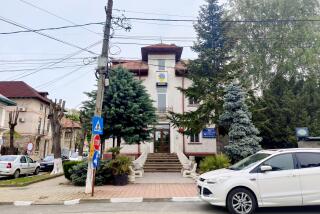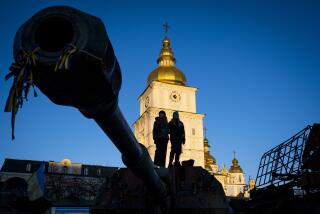In Romania, Plus Ca Change ....
On Dec. 21, 1989, Nicolae Ceausescu, absolute ruler of Romania for nearly a quarter of a century, fled the jeers and catcalls of an angry crowd in the center of Bucharest. On Dec. 25, he and his wife Elena, a nagging, malign shrew, were tried by a kangaroo court representing the newly formed National Salvation Front, and executed with a hail of bullets. Photographs of their bloody corpses were promptly flashed around Romania and the world. The Antichrist had died on Christmas Day.
The two books under review--one by Newsweek correspondent Edward Behr, the other by Andrei Codrescu, poet, professor and commentator on National Public Radio--complement each other. Behr, the more accessible writer, provides lucid journalism: clear, sometimes inaccurate, yet generally right. Codrescu, the more charming, is also more subjective, impressionistic and personal: His is an emotional homecoming. But both make clear that the Antichrist died only to rise again. Romanians had lived under Romanian occupation since 1945. They live so still.
Behr begins with the end: the tyrant couple abandoned by all, the farcical court proceedings that could have been dispensed with, the sordid execution. As he gallops through Romanian history from ancient origins to the Communist coup of 1945, he overstates the extent of the Communists’ influence before the Red Army opened their way to power. (Exaggerating little, Codrescu’s uncle deemed the Communists “a thousand Russian spies.”)
But Behr does make clear how foreign to Romania communism was, spawned by the detested Russian neighbor and led by Poles, Bulgarians, Hungarians, Jews. Hence the value to the Communists of George Gheorghiu-Dej and of his satellite Nicolae Ceausescu, both authentic Romanian working men of peasant stock.
In 1965, when Gheorghiu-Dej, who had ruled Romania since 1948, died of cancer and was succeeded by his henchman, Ceausescu’s new look stood in stark contrast to the stale bureaucracy he inherited. An anti-Russian nationalist, the only Communist leader to protest against the Soviet invasion of Czechoslovakia in 1968, the only one to ignore the Soviet boycott of the Los Angeles Olympics, Ceausescu became the darling of the West.
He managed to coexist with capitalists and anticapitalists, Arabs and Israelis, industrial and Third World countries. But the glowing image fueled by forthcoming international bankers faded fast. Unable to sell enough of its shoddy, uncompetitive industrial products, Romania was reduced to renting out Romanian workmen to labor in the natural gas fields of Central Asia, selling ethnic Germans back to West Germany, Jews to Israel, and babies for adoption to all comers. (By 1982, the New York Times described the situation as organized economic disaster.)
The country remained underdeveloped, inequitable, and oppressive to many. It had been so before 1945, but then it was also rich, lush, colorful, and amply provided with food and raw materials. Now it was necessitous, famished and sick at heart. Severe food shortages became endemic, bread and electricity were rationed, bulbs stronger than 40 watts prohibited. The average citizen lived in ravaged, blacked-out cities, in warlike austerity.
Ceausescu’s grand mega-industrial complexes were, as Behr illustrates, caricatures of counterproductivity. And the ruin of cities and villages perfected the ruin of the economy. A visit to North Korea had filled the parvenu Marxist with admiration for Pyongyang, its endless wide avenues and miles of identical apartment blocks.
The great earthquake of 1977 would stimulate his interest in urban renewal--or perhaps urban rape. Countrywide, “archaic” villages were replaced by jerry-built urban slums. In the capital, “archaic” landmarks, monasteries, churches, dwellings, made way for the dictator’s lair: the largest, ugliest building in the world. Three times the size of Versailles, bigger than the Pentagon, its reception hall the size of a football field and its five-ton chandelier consuming more electricity than several villages, this People’s Palace forbidden to the people bore witness to a megalomaniac’s petty bourgeois tastes.
To this and other disasters, Romanians reacted (and still react) with glum jokes: Bucharest became Ceaushwitz, Ceaushima, Paranopolis; the dynasty that ruled them represented socialism in one family. But gallows themselves were less evident than gallows humor. Romania, Ceausescu could boast, had fewer political prisoners than did Yugoslavia. Intimidation sufficed to cow and silence most; temptation seduced others to nauseating adulation.
Although Codrescu believes that writers and poets kept their integrity in the corruption of the Ceausescu years, I tend to agree with Behr that intellectual resistance remained exceptional. I know the exceptions. But most intellectuals proved as opportunistic as passive. Credit for this goes less to the dread Securitate than to long national traditions of sycophancy, to natural desire to stay out of trouble, to immemorial beliefs that bending, however low, beats breaking every time.
One word both authors use a lot is “ambiguous,” which my dictionary defines as “obscure; of double meaning; of doubtful classification; of uncertain issue”--all of which apply to the Romanian situation. The first fully televised revolution bears witness to television’s endless possibilities for fabrication, falsification and manipulation.
For Behr, the events of December, 1989, remain ambiguous. For Codrescu, they are “F/X”: a play staged to fool Romanians, and also foreigners begging to be fooled, while rival gangs of soldiers and Securitate vie to steal the revolution for themselves.
In this respect, Codrescu, who sees in Ceausescu’s fall a palace conspiracy designed to replace one Communist junta by another, seems closer to the truth. Many institutions changed their name after Christmas, 1989, but little else that matters really changed, except perhaps the right to complain about it.
The Communist Party, briefly banned in January of 1990, was back in business within days. The elections of May, 1990, gave the National Salvation Front 83% of the votes cast, close to Ceausescu’s majorities. Freely elected, one Communist dictatorship has replaced another. The country’s leadership reflects this: graduates of the Party school, agents of the KGB, and a prime minister, Petre Roman, the son of a Party founder and privileged member of a privileged nomenklatura that also soldiers on.
Under their rule, the police, the judiciary and the bureaucracy remain largely intact, their power resting, as it used to do, less on cruelty than on petty meanness. Political debate, as in the old days, is limited to the dialectics of pots calling kettles black. The not-so-secret Securitate (renamed the Romanian Information Service), is back at work; radio and TV are completely controlled; the rumor mills grind as before. For 45 years, 23 million Romanians have stood in line for the bare essentials of life; they stand in line today.
Codrescu, who rues all this, nevertheless welcomes the bells of Bucharest when they ring loud and clear. But the churches from which they ring are themselves both subservient to the state and sympathetic to the ultranationalist Vatra Romaneasca, a political movement that is as xenophobic, chauvinistic and antisemitic as the Romanian Orthodox Church. The mushroom growth of the Vatra Romaneasca, like the bloody clashes between Romanians and Hungarians in Transylvania, reflect widespread frustration, resentment and hatred, easy to turn against Hungarians, Gypsies and Jews. “Once united in hatred of Communism,” Codrescu quotes the poet Ana Blandiana as saying, “Romanians now hate each other indiscriminately.”
Some pray for peace and quiet, others simply hope to get away--preferably to America where, Codrescu’s grandmother used to say, dogs walk around with pretzels on their tails. Meanwhile, both these sketches of “Romania Anno Zero” suggest that the next acts of this gory melodrama will take some generations to play out.
More to Read
Sign up for Essential California
The most important California stories and recommendations in your inbox every morning.
You may occasionally receive promotional content from the Los Angeles Times.










